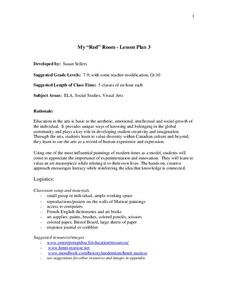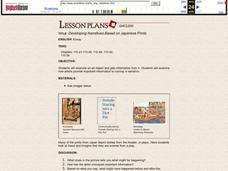Classics for Kids
"Mars" from The Planets
Gustav Holst's The Planets provide young musicians an opportunity to examine how composers can create a suite: a collection of smaller pieces grouped to explore a single topic. After listening to "Jupiter," they examine "Mars" in detail,...
Civil War Trust
The Common Civil War Soldier
Imagine you are a soldier in the Civil War. What are you wearing? What do you need to carry with you? Examine the life of a person during the Civil War, from drummer boys to powder monkeys to musket-toting soldiers. Elementary learners...
Curated OER
Art Across the Planet
Students create drawings of their own homes and those that they imagine might be found in a foreign country, conduct research on that particular foreign country using exchange artwork and questions with another group of students in that...
Curated OER
String Art
Students create colorful works of art by folding construction paper in half, and pulling out pieces of string that are coated in paint.
Curated OER
Emily Dickinson & Poetic Imagination: "Leap, plashless"
Learners analyze the poems of Emily Dickinson and write their own nature poem. In this poetry analysis lesson, students read Dickinson poetry and analyze the use of imagery, sound, and metaphor. Learners write their own nature poem using...
Curated OER
Picasso Faces
Fifth graders discuss the artwork of Abstract artist Pablo Picasso. They create a collage of Abstract and/or Cubistic Faces emulating Picasso's style. Students are allowed to let their imagination run wild with the many possibilities.
Curated OER
Hurricane
Students use children's literature in order to investigate the concept of hurricanes and how they occur. The metaphor is used to describe a play area that is magical. They use their imaginations and write about their favorite places to...
Curated OER
Helen Frankenthaler Biography
Students examine the abstract art of Helen Frankenthaler. In this art analysis lesson, students complete a criticism of the aesthetics of the art, analyze the color use in the art, and research the history of abstract art.
Curated OER
Inside Scoop: Bearden
Students read paragraphs and examine images of the artist Romare Bearden. In this art analysis lesson, students read text about the life and art of Romare Bearden. Students study his medium of montages and then create their own example.
Curated OER
My "Red" Room
Students utilize art analysis skills by examining the work of Henri Matisse. In this painting lesson, students examine L'Atelier Rouge by Henri Matisse and identify the objects in the room and colors used. Students create their own rough...
Curated OER
Walk into the Desert, A Line and Wash Landscape
Students discuss a landscape art print and its composition. They create a landscape underdrawing with foreground, middleground and background as well as repeated elements for rhythm. They add a watercolor wash and lights/darks for...
Curated OER
DEVLOPING NARRATIVES BASED ON JAPAPNESE PRINTS
Students examine an art object and gain information from it. Students examine how artists provide important information to convey a narrative.
Curated OER
Touch-Drawings
Pupils explore an object without seeing it then draw what s/he felt. In this touch-drawings lesson, students partner and place objects in a paper bag so the other person cannot see it. Then pupils use their hands and imagination to...
Curated OER
Fantasy Allegory of Air
Students analyze the painting Jan Brueghel and design their own book. In this art and book lesson, students discuss the elements of fantasy from the painting and create their own book. Students illustrate the book and create a painting...
Curated OER
Imaginative Power - Exploring Superheroes
Third graders identify super human powers and their uses found in comic and cartoon characters, identify use of visual elements such as line, shape, and color, and create drawings of an original super character with at least two extra...
Curated OER
Officer Buckle and Gloria
Young scholars write a class letter to a local policeman asking him to come and talk to the class and create a list of safety tips as a class. Students research information on police dogs: type of dogs used, where they come form, how...
Curated OER
Rangoli - An Art of India
Young scholars respond to image of a rangoli, identify viewing context for selected rangoli image and how this affects viewer's ability to understand the artwork, investigate cultural values and purposes of rangoli art, and design and...
Curated OER
Finding Math In The World Of Art
Learners explore the use of Math in the world of Art. In this mathematics and visual art lesson, they design a picture using math digits that are camouflaged into a pictures. Additional cross curriculum activities are embedded in the plan.
Curated OER
Art of the Inca
Students examine the early civilizations of Central and South America. After examining hand-crafted objects, they discuss the craftsmanship of the Inca and how they used geometric shapes and symbols in their art. They draft a design...
Curated OER
Geometric Art In Our World
Students explore ways art and math can be blended together in world around them. They recognizes geometric shapes and designs in artwork, and create their own artwork blending the two concepts.
Curated OER
How to be an Individual: Analyzing Society's Influence on Us through Art and Literature
Pupils focus on interpreting difficult texts and analyzing the impact these texts can have on their own lives. They think more about who they want to be as individuals, and realize some of the constraints we have due to the real or...
Curated OER
Sculpture -Assemblage -Art of Mexico
Fifth graders create imaginative creatures are called Alebrijes.
Curated OER
The Art of Poetry: The Lunatic, The Lover, and the Poet
Students, in groups, reflect on their attitudes towards poets and poetry. They read excerpts from George Puttenham's The Arte of English Poesie, which was written during Shakespeare's day. They compare their attitudes toward poetry to...
Curated OER
Art and Literacy, grades 3-6, Reading Comprehension Category: Critical Stance
Students compare two very different works of art and two poems, and verbally list similarities and differences they perceive in the works of art and the poems; students then select poem that best correlates with a work of art.

























